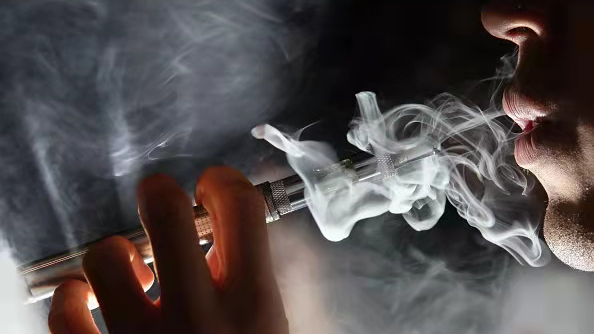
Editor's note: Dr. Nilesh Parmar, one of a few dentists in the UK to have a degree from all three London Dental Schools, is a dentist and co-founder of Parmar Dental. The article reflects the author's views and not necessarily those of CGTN.
The pandemic has not only turned us into health fanatics, but shown us the importance of sound respiratory health more than ever – but has our COVID-19 response glossed over the detrimental effects of one socially accepted behavior: vaping?
We know that cigarette smokers tend to suffer more from COVID-19. In fact, a review by the World Health Organization (WHO) found that smoking is associated with severe illness and an increased risk of death in those who need hospital treatment for COVID-19.
There is evidence to suggest the same is true for vapers, with the National Institute on Drug Abuse warning that those who vape are hit "particularly hard" by COVID-19.
While many would denounce smoking for its general health consequences, people seldom share the same attitude for its comparably harmful alternative – vaping. In the past decade, vaping – which is the practice of inhaling and exhaling vapor containing nicotine and flavoring – has become commonplace, particularly among the youth.
Often used as a quitting method to smoking cigarettes, vaping is even recommended as an alternative by Public Health England (PHE). But have they got it wrong?
Vaping, to an extent, is a relatively new phenomenon, and while less harmful than cigarettes, it's causing another health crisis. In 2019, just before the onslaught of COVID-19, vaping-related pneumonia landed over 2,000 individuals in hospitals in the U.S.
What's worth noting is that symptoms of individuals with vaping-related pneumonia in the U.S. are highly similar to those infected with COVID-19, based on findings from leading experts who conducted detailed research on 250 computerized tomography images of 142 patients suffering from vaping-related pneumonia.
The same year, doctors in Michigan performed what they believed was the first double lung transplant on a patient whose lungs were damaged from vaping. Excessive vaping is also associated with several toxic effects at molecular, cellular, tissue, organ and system levels, according to a study by the Sapienza University of Rome.
They found that electric vaping cigarettes impacted adversely on blood pressure management, caused tachycardia, and worsened arterial stiffness. It was also associated with an increased risk of adverse clinical events, including atrial fibrillation and myocardial infarction, even if the causal link is still being debated.
While the effects of using electronic cigarettes are of a fewer magnitude than its traditional counterpart, we have yet to see its long-term consequences. Indeed it may be safer but its effects cannot be underplayed. Saying vaping is a solution to smoking is akin to recommending cocaine to quit heroin. The harm is still very real.
And while many smokers stopped smoking with the aid of vaping products who would otherwise have carried on smoking, no one is monitoring their usage afterwards. If vaping simply replaces smoking habits, smokers are still putting themselves at risk – they may even end up vaping more than they would have smoked normal cigarettes. Such smokers are often pushed outside if they want to light one up, as laws in many parts of the world prohibit them from smoking cigarettes indoors.
However, there are no laws to prevent people from vaping inside. Consider how inconspicuous these devices are too – schoolchildren can sneak them into school without much trouble. They may even vape during class and inhale/exhale strategically (long, slow inhales can certainly be harmful), to avoid detection.

A vape store in San Francisco, California, U.S., June 26, 2019. /Getty
A vape store in San Francisco, California, U.S., June 26, 2019. /Getty
Vaping shops are also easily accessible without the same scrutiny as behind-the-counter cigarettes, which have more stringent punishments if sold to under-18s. Easy access to e-cigarettes can also become a gateway to smoking cigarettes and shisha (in an hour, a shisha smoker can inhale the same amount of toxins as a cigarette smoker consuming over 100 cigarettes.)
So what should be done? The normalization of vaping needs to stop, and it must come from the government level. As in New York, which became the fourth state to ban fruity vaping flavors, the UK too must stop selling sweet, enticing flavors. Flavorless and tobacco-tasting vapes will not be as compelling for youngsters as an array of sweet-smelling flavors that can quickly become addictive.
Vaping products could also come with health warnings – we've all seen the harrowing images of lung damage emblazoned across cigarette packets – vapers should also be aware of the consequences. Policy makers can also reconsider the minimum age to purchase e-cigarettes (and/or punishments for those who offer it to minors). And critically, health professionals should rethink recommending it as a smoking cessation option.
Additionally, the e-cigarette market needs to be regulated – there's no standardization which ensures that quality oils and ingredients are used. Indeed there are some mainstream vaping companies that follow the law, sell quality compound ingredients, with proper packaging, but youngsters with small budgets will not be accessing these, and they may be more likely to go for the cheaper, more unsafe options.
And not only can it cause bodily harm, but e-cigarettes can be a fire hazard. If the wrong vaping equipment is used, chargers can heat up to dangerous temperatures. The number of fire incidents related to e-cigarettes has grown rapidly and figures published by the BBC revealed that e-cigarettes are believed to be the cause of more than 100 fires in less than two years. If we want to prevent lung damage caused by excessive vaping and other risks, we must act now, before we have another epidemic on our hands.
(If you want to contribute and have specific expertise, please contact us at opinions@cgtn.com.)

